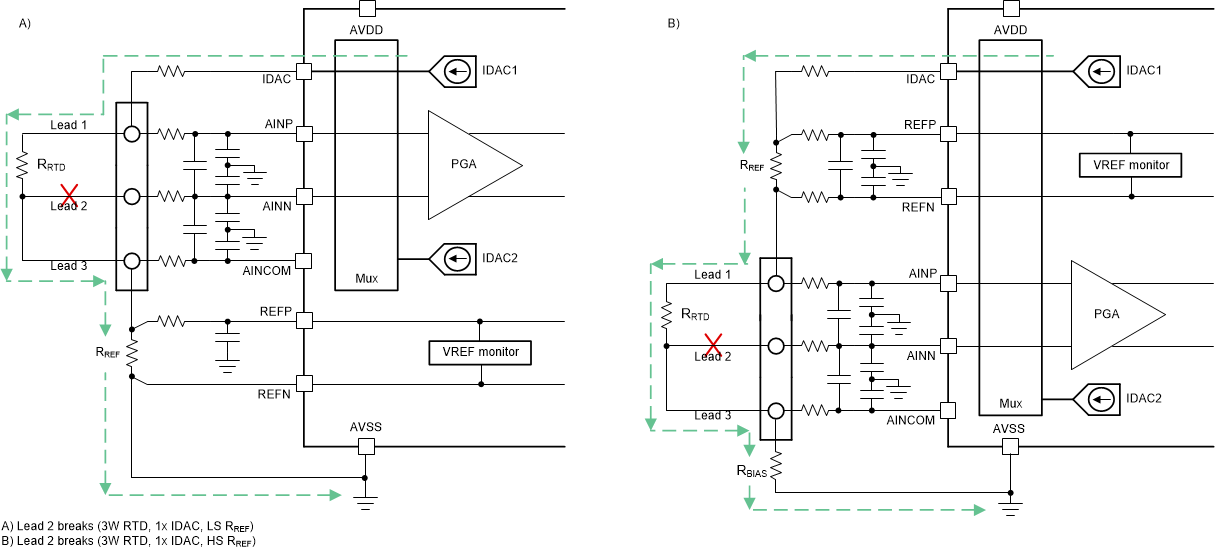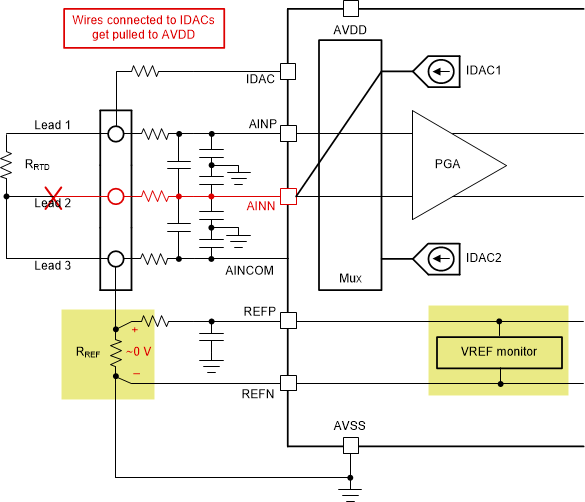SBAA483 February 2021 ADS1120 , ADS112C04 , ADS112U04 , ADS114S06 , ADS114S06B , ADS114S08 , ADS114S08B , ADS1220 , ADS122C04 , ADS122U04 , ADS124S06 , ADS124S08 , ADS125H02 , ADS1260 , ADS1261 , ADS1262 , ADS1263
- Abstract
- Trademarks
- 1Introduction
- 2Features Used to Detect Wire Breaks in RTD Systems
- 3Wire-Break Detection Methods for Different RTD Configurations
- 4Settling Time Considerations for RTD Wire-Break Detection
- 5Summary
- A How Integrated PGA Rail Detection Helps Identify Wire Breaks
- B Pseudo-Code for RTD Wire-Break Detection
3.2.1.1 Detecting a Break in Lead 2 in a One-IDAC, 3-Wire RTD System
As stated in Section 3.2.1, the VREF monitor cannot detect a break in lead 2 when using a one-IDAC, 3-wire RTD system. In other words, a fault can occur during normal operation that cannot be detected by the VREF monitor alone. Data may start to deviate from the expected value, but do not assume that this deviation results from a wire break as opposed to some other system anomaly. Figure 3-3 shows this behavior.
 Figure 3-3 No VREF Monitor Fault When
Lead 2 breaks in a One-IDAC, 3-Wire RTD System Using a Low-Side (Left) and
High-Side (Right) RREF
Figure 3-3 No VREF Monitor Fault When
Lead 2 breaks in a One-IDAC, 3-Wire RTD System Using a Low-Side (Left) and
High-Side (Right) RREFIn order to detect a wire break, perform a diagnostic measurement by first halting precision RTD measurements and then changing the system configuration settings. Because RTD measurements must be stopped in this case, choose how often to interleave diagnostic measurements by balancing increased latency with the required system response time to a fault condition.
Detecting a break in lead 2 using a one-IDAC, 3-wire RTD system requires differentiating between a low-side and a high-side RREF configuration as well as switching the IDAC output to a different analog input. Some ADCs do not integrate the functionality to route an IDAC to any analog input, especially ADCs with dedicated IDAC pins. Therefore, external circuitry may be required to perform this function. Either way, Figure 3-4 illustrates how to enable the IDACs using a low-side RREF.
 Figure 3-4 Diagnostic Measurement Checks
if Lead 2 is Broken Using a Low-Side RREF
Figure 3-4 Diagnostic Measurement Checks
if Lead 2 is Broken Using a Low-Side RREFIn the low-side RREF case, switch the IDAC current to flow through lead 2. Then, use the VREF monitor to indicate a fault just as if lead 1 or lead 3 is broken. The high-side RREF case is more complicated, requiring a dedicated discussion as described in Section 3.2.1.1.1.